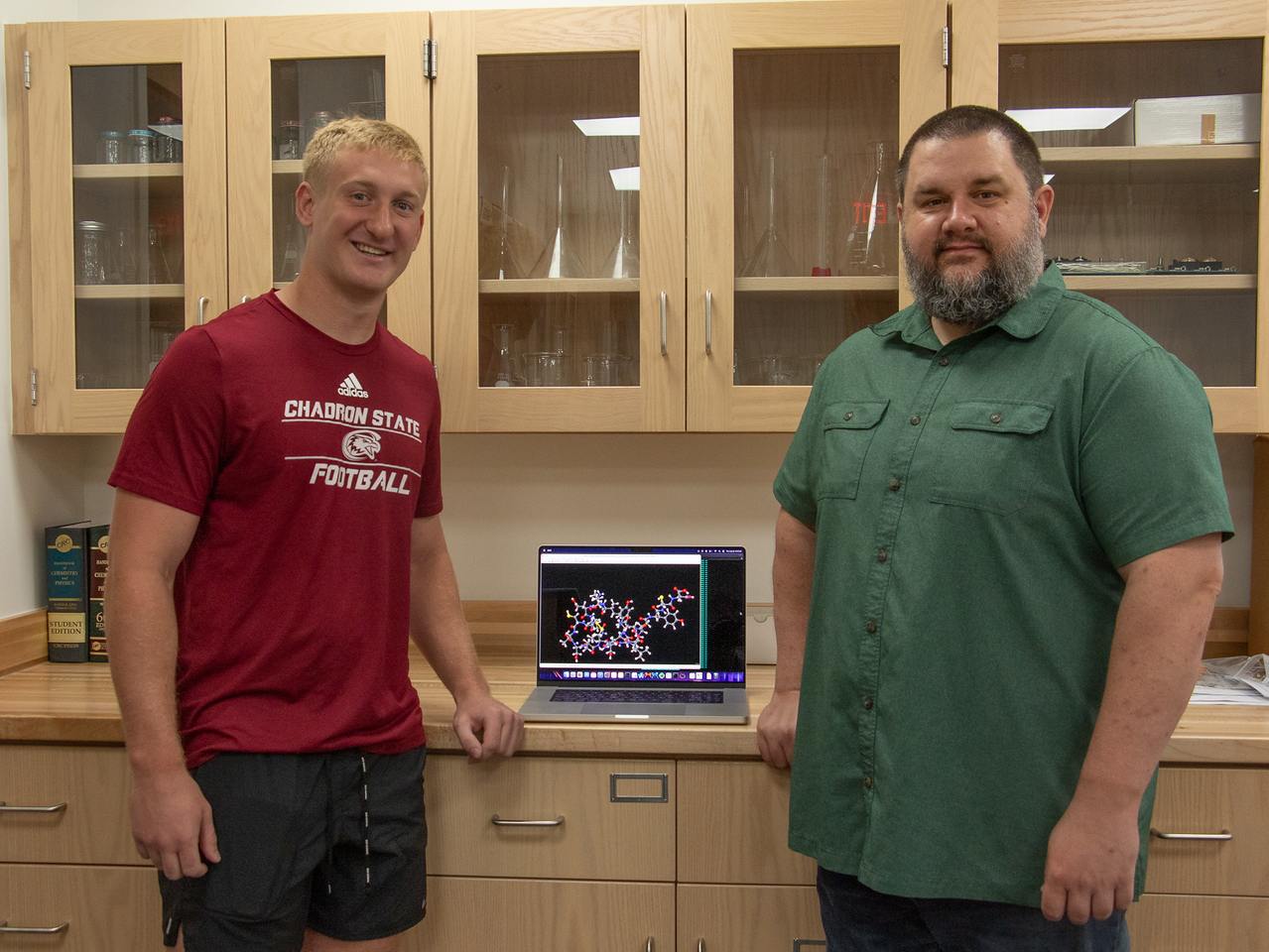![]()
By Tena Cook, CSC Marketing Coordinator

Chadron State College senior Sutton Pohlman of Stanton, Nebraska, will present a poster about his capstone course research at the National Science Foundation (NSF) and Established Program to Stimulate Competitive Research (EPSCoR) conference in Omaha in October. Assistant Professor Clint Evrard, who will travel with Pohlman, said he is excited to share the research he and Pohlman are conducting.
Pohlman’s research is about insulin uptake in the system of a person with type II diabetes. The NSF provided funding to the University of Nebraska-Lincoln through a cooperative agreement with the approval to fund sub-awards for undergraduate research. Evrard submitted a proposal to the UNL EPSCoR program and was awarded $5,000 for a laptop, which can conduct computational and quantum chemical research.
“The project is still fairly new, but Sutton will have enough data to present,” Evrard said. Pohlman, in the pre-medicine track of the Rural Health Opportunities Program, will earn his bachelor’s degree in chemistry in December. He plans to pursue a master’s in business administration with a healthcare focus at CSC while continuing to play football. After earning an MBA, he plans to attend the University of Nebraska Medical Center.
Evrard said he plans to publish the research he and Pohlman will conduct during Pohlman’s master’s program.
“Sutton will be a published co-author before he enters medical school, and it will get Chadron State College’s name in an article published in a major journal,” Evrard said.
Evrard said the laptop has 96 gigabytes of memory, a four-terabyte storage system, and a new Apple M3 silicon chip that runs on ARM technology, uses less energy, and creates less heat.
“This machine can solve thousands of equations at the same time and won’t melt down when running at its highest performance. Also, if we ever want to connect to a supercomputer at a big university or a national laboratory, this will connect to those flawlessly,” Evrard said.
Pohlman said the technology can show insulin at the atomic level, which is helpful in research. “We’re trying to figure out why insulin isn’t binding to its receptor in people with type II diabetes. Insulin could be competing with a growth hormone, or be affected by changes in the pH. Other factors could prevent insulin binding. Insulin binding is important because in type II diabetes, glucose builds up in the bloodstream and can cause various issues, such as kidney and vision damage and poor circulation in the extremities,” Pohlman said.
Evrard explained that he and Pohlman are using ORCA, an open-source quantum chemistry software, to learn more about the delicate process of insulin binding.
“The ORCA technology, developed by a research institute in Germany, allows us to move the molecule around so we can view all the atoms at different angles. The structures work together as a molecule to produce different chemical results. We’re on the ground level with them and can keep using the software even after they start marketing it,” Evrard said.
Evrard and Pohlman describe the Apple MacBook Pro they are using as a souped-up supercomputer.
“Compared to a normal laptop, this is a Ferrari. Inside the M3 chip, there are 18 central processing units and 30 graphics processing units,” Evrard said. “We use all of those simultaneously because the ORCA platform can use another program called Open MPI, which takes all the completed computations and puts them back together into a single solution.”
Pohlman said the program finds every possible way the molecule could arrange itself and then finds the best way for the molecule to bind with insulin.
“We’re trying to capture (visual representations of) all the chemical reactions (in insulin binding) so we will eventually see the electrons and the final structure. It will be a very accurate model,” Evrard said.
Evrard added that chemists and doctors who conduct research in a wet lab measure their starting compounds and ending compounds.
“We take their work, and this program shows what happens in a chemical reaction step by step instead of just the beginning and ending products. Sutton is the first student to use this technology, and I want to get more students involved in several different research pathways,” Evrard said.
One project Evrard has planned is something he learned in his doctoral program at the University of Louisville.
“They worked on delivering cancer drugs to the system using vitamin B12 as a shuttle. The great thing about vitamin B12 is that it has the potential to release the cancer drug only when it arrives at the cancer site. So, the patient no longer gets chemotherapy throughout their entire body,” Evrard said.
Evrard also plans projects to capture methane from natural gas and upcycle it into usable compounds for industry such as methanol or ethanol.
The technology can also calculate the chemical interactions of nano compounds designed to be dropped on plastics that, when activated by sunlight, will break them down again into their base compounds so they can be reused in industry.
“The last two projects I’ll put on this machine are molecular electronics and battery technologies. The goal is to calculate the quantum mechanics involved in all of these technologies very accurately,” Evrard said.
